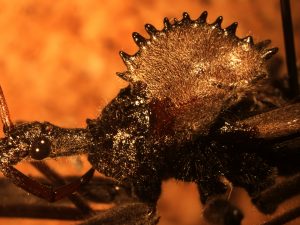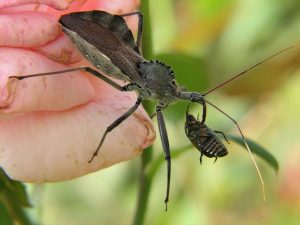by Ryan Bohrod
Insects surround us everyday, and whether we realize it or not, we still have daily interactions with these little critters. One insect that can be found in our very own backyards here in Allentown, Pennsylvania in late spring through autumn is the Wheel Bug (Arilus cristatus). Wheel Bugs are a type of assassin bug and are commonly mistaken for the “deadly kissing bug”. The real kissing bug can infect humans with the microscopic organism that causes Chagas Disease by “peeing” on a victim while it is feeding. While the Wheel Bug doesn’t pose any serious long-term health risks to humans, it has been known to defend itself with a painful bite that can be more powerful than a bee sting. The site of the bite has been known to become numb for several days after the initial pain has worn off and the entire area usually is healed after two weeks. A bite from a wheel bug does have the potential to become infected, however this can be easily avoided with the use of a topical antimicrobial ointment.

While the Wheel Bug shares a similar body shape and size with the “deadly kissing bug”, this insect can be properly identified by a crest on its thorax that is shaped like a wheel with protruding cogs around the outside. It is also characterized by its skinny neck, noisy flight, and its large body that can be as long as a silver dollar. These insects can be found all over the continental United States and as far south as Mexico. The life cycle of the Wheel Bug is a one-year long generation that spends the winter season in the egg stage before hatching in the spring, not unlike us humans who like to spend the cold winter months indoors before emerging in beautiful spring weather!
Wheel Bugs are predatory insects and commonly prey on pest insects such as caterpillars. They are part of a group of insects known as assassin bugs, whose vicious style of eating matches their violent name. Wheel Bugs and other assassin bugs liquefy the insides of their prey before sucking it out of the victim’s body. They do this by piercing prey with their beaks and injecting enzymes in their saliva that dissolve the bug’s insides. Wheel Bug saliva is powerful enough to paralyze and kill prey within 30 seconds of being bitten. Their long piercing beaks are folded down when not in use and stored on a groove that runs along the underside of their thorax like how an airplane stores its landing gear while in flight. Wheel Bugs are also known to be very aggressive at both nymph and adult stages in their natural habitats, with some nymphs even showing cannibalistic behavior. It has also been found that the larger females sometimes kill and feed upon males soon after mating with them.
CC Some Rights Reserved
Photo Credit: Audrey
Despite their aggressive nature and painful bite, Wheel Bugs should be welcomed in gardens and yards as esteemed guests of honor due to their ecological importance. These bugs are very efficient predators and act as guardians of the garden, defending it from pests who would feed on the plants if left uninterrupted. Some of the pests that the Wheel Bug preys on include beetles, aphids, grasshoppers, crickets, caterpillars, and stink bugs and other true bugs. Unfortunately our protectors of the garden may be too efficient of hunters, as they don’t only eat pest bugs but also eat beneficial insects such as ladybugs and honeybees. Nevertheless, Wheel Bugs still provide a net benefit to any garden or community of plants. In fact, the presence of these bugs in a garden is seen as an indication that the community is thriving and healthy. This is because Wheel Bugs are at the top of their food chain, the highest-level predator in the garden, and when their population numbers are thriving, it indicates that all of the other food web levels are intact and that the environment is healthy and free of pesticides and contaminants. Wheel Bugs are so beneficial to environments that they are welcomed as a form of organic pest control by rural and urban gardeners.
Wheel Bugs are fascinating insects that can be found in our very own backyards and are a productive part of local ecology, and, if treated with precaution and respect, are completely harmless to humans. Although they are very good at camouflaging with their environment they can be found by looking for their giant wheel shaped crest on their thoraxes. Just remember not to touch them or be prepared to potentially face a bite that is said to be worse than a hornet’s sting! According to a classic 1924 article, the sting of a wheel bug was said to be equivalent or more painful than insects that scored a 3 out of 4 on the Schmidt Pain Index. Still, Wheel Bugs should be viewed as friends not foes, as they contribute to the health of gardens and the local ecosystem.
